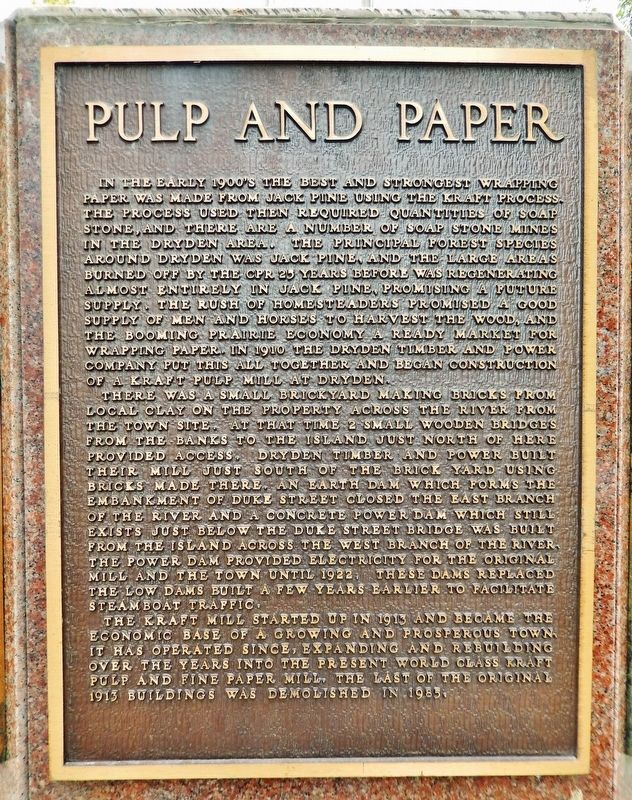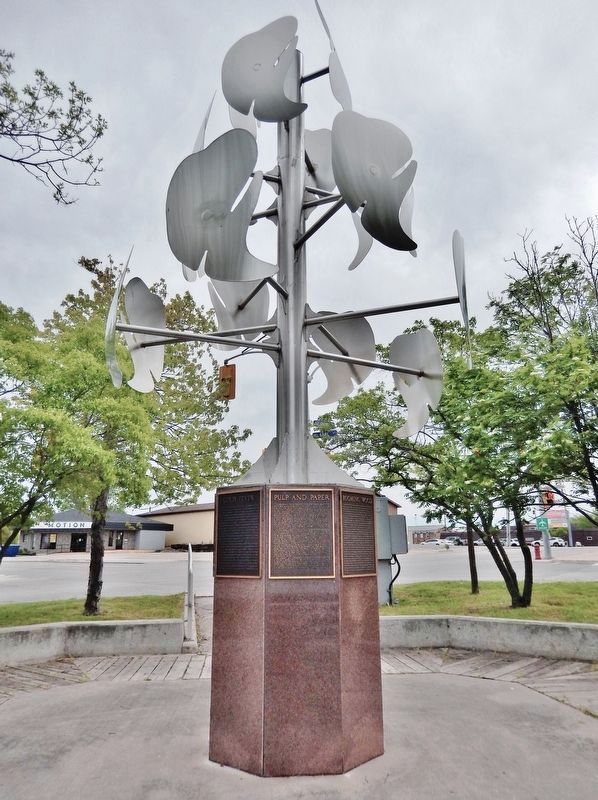Dryden in Kenora District, Ontario — Central Canada (North America)
Pulp and Paper
In the early 1900’s the best and strongest wrapping paper was made from Jack Pine using the Kraft process. The process used then required quantities of soap stone, and there are a number of soap stone mines in the Dryden area. The principal forest species around Dryden was Jack Pine, and the large areas burned off by the CPR 25 years before was regenerating almost entirely in Jack Pine, promising a future supply. The rush of homesteaders promised a good supply of men and horses to harvest the wood, and the booming prairie economy a ready market for wrapping paper. In 1910 the Dryden Timber and Power Company put this all together and began construction of a Kraft pulp mill at Dryden.
There was a small brickyard making bricks from local clay on the property across the river from the town site. At that time 2 small wooden bridges from the banks to the island just north of here provided access. Dryden Timber and Power built their mill just south of the brick yard using bricks made there. An earth dam which forms the embankment of Duke Street closed the east branch of the river and a concrete power dam which still exists just below the Duke Street Bridge was built from the island across the west branch of the river. The power dam provided electricity for the original mill and the town until 1922. These dams replaced the low dams built a few years earlier to facilitate steamboat traffic.
The Kraft mill started up in 1913 and became the economic base of a growing and prosperous town. It has operated since, expanding and rebuilding over the years into the present world class Kraft pulp and fine paper mill. The last of the original 1913 buildings was demolished in 1985.
Topics. This historical marker is listed in these topic lists: Horticulture & Forestry • Industry & Commerce • Settlements & Settlers • Waterways & Vessels. A significant historical year for this entry is 1910.
Location. 49° 46.916′ N, 92° 50.462′ W. Marker is in Dryden, Ontario, in Kenora District. Marker is at the intersection of West River Road (Duke Street) (Provincial Highway 594) and Earl Avenue, on the right when traveling east on West River Road (Duke Street). The marker is mounted on the granite base of a metal sculpture at the southwest corner of the intersection, overlooking the Duke Street Dock. Touch for map. Marker is at or near this postal address: 18 Duke Street, Dryden ON P8N 1Y1, Canada. Touch for directions.
Other nearby markers. At least 8 other markers are within walking distance of this marker. Booming Wood (here, next to this marker); Gold Fever (here, next to this marker); Recreation (here, next to this marker); The Present (here, next to this marker); Agriculture (here, next to this marker);
The Railway (here, next to this marker); Beginnings (here, next to this marker); Alan Durance (within shouting distance of this marker). Touch for a list and map of all markers in Dryden.
Related markers. Click here for a list of markers that are related to this marker.
Also see . . .
1. Paper and pulp industry in Dryden, Ontario (Wikipedia). Excerpt:
In 1909, Charles and Grant Gordon began the construction of a paper mill on the west side of the Wabigoon River, where a paper mill is currently located. The mill's location has some advantages, because it has an abundant electricity supply from the river and a plentiful supply of wood. In 1911, the rights of the timber lease were transferred from the Gordon brothers to the Dryden Timber and Power Company because the building they were constructing burned down in 1910, and they did not have means to complete their project. Dryden Timber and Power Company constructed a new mill and started to operate in 1913; it was the first Kraft pulp mill in Northwestern Ontario.(Submitted on March 15, 2024, by Cosmos Mariner of Cape Canaveral, Florida.)
2. Kraft Process (Wikipedia). Excerpt:
The kraft process (also known as kraft pulping or sulfate process) is a process for conversion of wood into wood pulp, which consists of almost pure cellulose fibers, the main component of paper. The kraft process involves treatment of wood chips with a hot mixture of water, sodium hydroxide (NaOH), and sodium sulfide (Na2S), known as white liquor, that breaks the bonds that link lignin, hemicellulose, and cellulose. The technology entails several steps, both mechanical and chemical. It is the dominant method for producing paper.(Submitted on March 15, 2024, by Cosmos Mariner of Cape Canaveral, Florida.)
3. 100 years and beyond – Dryden Mill, by Gwen Johnston (pdf). Excerpt:
Beginning production in 1913, the Dryden mill was the first kraft pulp mill in Ontario, and only the fourth in Canada...(Submitted on March 15, 2024, by Cosmos Mariner of Cape Canaveral, Florida.)
Credits. This page was last revised on March 16, 2024. It was originally submitted on March 14, 2024, by Cosmos Mariner of Cape Canaveral, Florida. This page has been viewed 26 times since then. Photos: 1, 2. submitted on March 15, 2024, by Cosmos Mariner of Cape Canaveral, Florida.

